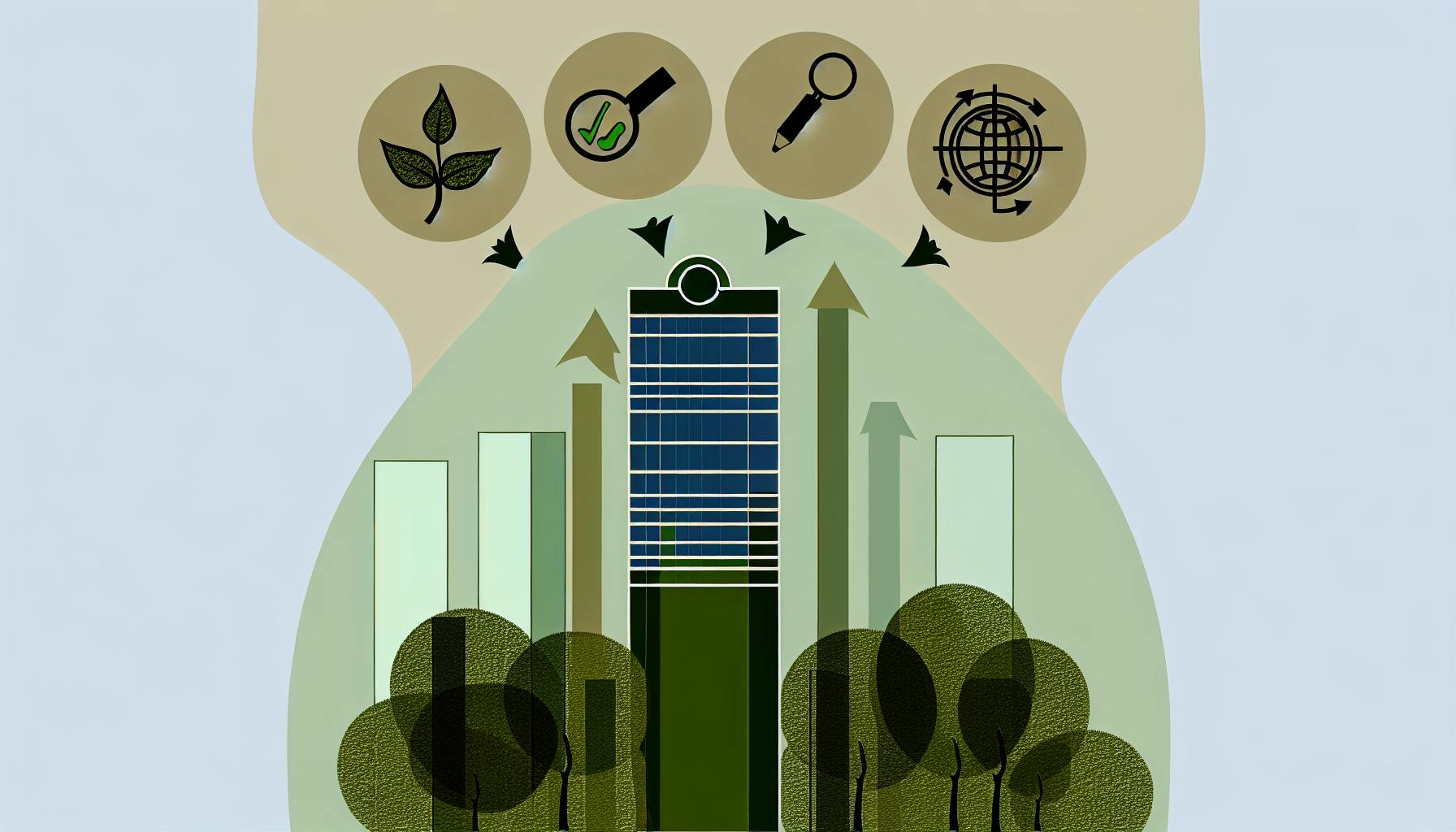Carbon accounting software helps organisations track and manage their greenhouse gas emissions across Scopes 1, 2, and 3. By using these tools, businesses can identify areas for improvement, set reduction targets, and develop strategies to mitigate their environmental impact.
When choosing a carbon accounting software, consider these key factors:
- Scope Coverage: Tracks emissions across all three scopes
- Integration and Analytics: Integrates with existing systems and provides real-time analytics
- Supplier Engagement and Support: Enables supplier collaboration and offers personalised support
- Cost and User Experience: Cost-effective, easy to use, and scalable
- Industry Expertise and Compliance: Experience in your industry and generates regulatory-compliant reports
Here are the top 10 carbon accounting software solutions for SMEs:
| Software | Key Features |
|---|---|
| Persefoni | Free emissions reporting, AI-powered automation, user-friendly interface |
| Microsoft Sustainability Cloud | Integrates with Microsoft suite, real-time analytics, scalable |
| Net Zero Cloud by Salesforce | Integrates with Salesforce, real-time analytics, three pricing plans |
| IBM Environmental Intelligence Suite | Integrates with various data sources, real-time analytics, cost-effective |
| Sphera | Covers Scopes 1, 2, and 3, integrates with data sources, real-time analytics |
| Sinai Technologies | Reputable emission factors database, helps reduce costs |
| Emitwise | Full Scope 3 coverage, real-time data collection, supplier collaboration |
| Greenly | Covers Scopes 1, 2, and 3, real-time data collection, supplier collaboration |
| Diligent | Connects to internal platforms, real-time dashboards, carbon calculator |
| Sweep | Covers GHG Protocol across all scopes, integrates with data sources, supplier engagement |
Evaluation Factors
When choosing a carbon accounting software, there are several key factors to consider. These factors will help you determine which software is best suited for your organisation's specific needs and goals.
Scope Coverage
The software should be able to track and measure emissions across all three scopes:
| Scope | Description |
|---|---|
| 1 | Direct emissions from owned or controlled sources |
| 2 | Indirect emissions from purchased energy |
| 3 | Value chain emissions |
Integration and Analytics
The software should be able to:
- Integrate with existing systems and data sources
- Provide real-time analytics and reporting capabilities
Supplier Engagement and Support
The software should have features that enable:
- Supplier engagement and collaboration
- Personalised support and training
Cost and User Experience
The software should be:
- Cost-effective
- Easy to use with an intuitive interface
- Scalable to grow with your organisation
Industry Expertise and Compliance
The software provider should:
- Have experience working with organisations in your industry
- Be able to generate reports that meet regulatory requirements and industry standards
1. Persefoni
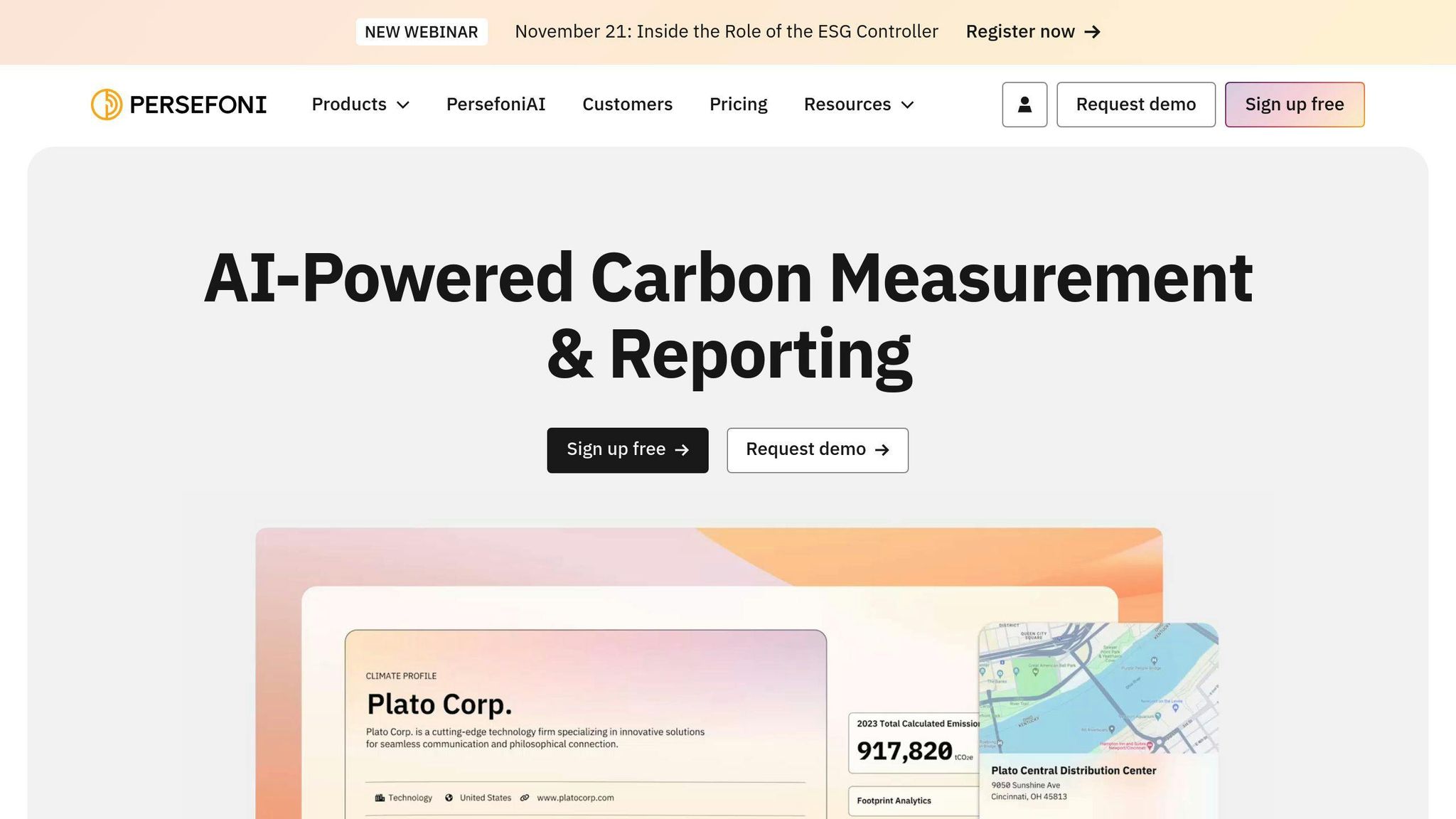
Persefoni's carbon accounting platform is a comprehensive tool that helps businesses track and manage their carbon emissions. Here's an overview of its features and capabilities:
Scope Coverage
Persefoni covers all three scopes of emissions:
| Scope | Description |
|---|---|
| 1 | Direct emissions from owned or controlled sources |
| 2 | Indirect emissions from purchased energy |
| 3 | Value chain emissions |
Integration and Analytics
Persefoni integrates with existing systems and data sources, making it easy to collect and analyse emissions data. The platform uses AI to automate data formatting, detect anomalies, and allocate emission factors, reducing the time and effort required for data management.
Real-time Analytics
Persefoni provides real-time analytics and reporting capabilities, allowing businesses to track their emissions and make data-driven decisions.
Cost and User Experience
Cost-effectiveness
Persefoni offers a free emissions measurement and reporting solution (Persefoni Pro) for businesses, making it accessible to businesses of all sizes and industries.
User Interface
Persefoni's platform is designed to be user-friendly, with an intuitive interface that makes it easy to navigate and use. The platform also provides personalised support and training to ensure that users get the most out of the platform.
Scalability and Industry Expertise
Scalability
Persefoni's platform is scalable, making it suitable for businesses of all sizes and industries.
Industry Experience
Persefoni has experience working with businesses in various industries, including enterprise, financial institutions, and SMB markets.
Compliance and Reporting
Persefoni's platform is designed to meet regulatory requirements and industry standards, including GHGP and PCAF. The platform's reporting capabilities also enable businesses to generate reports that meet the requirements of various stakeholders, including investors, regulators, and customers.
2. Microsoft Sustainability Cloud
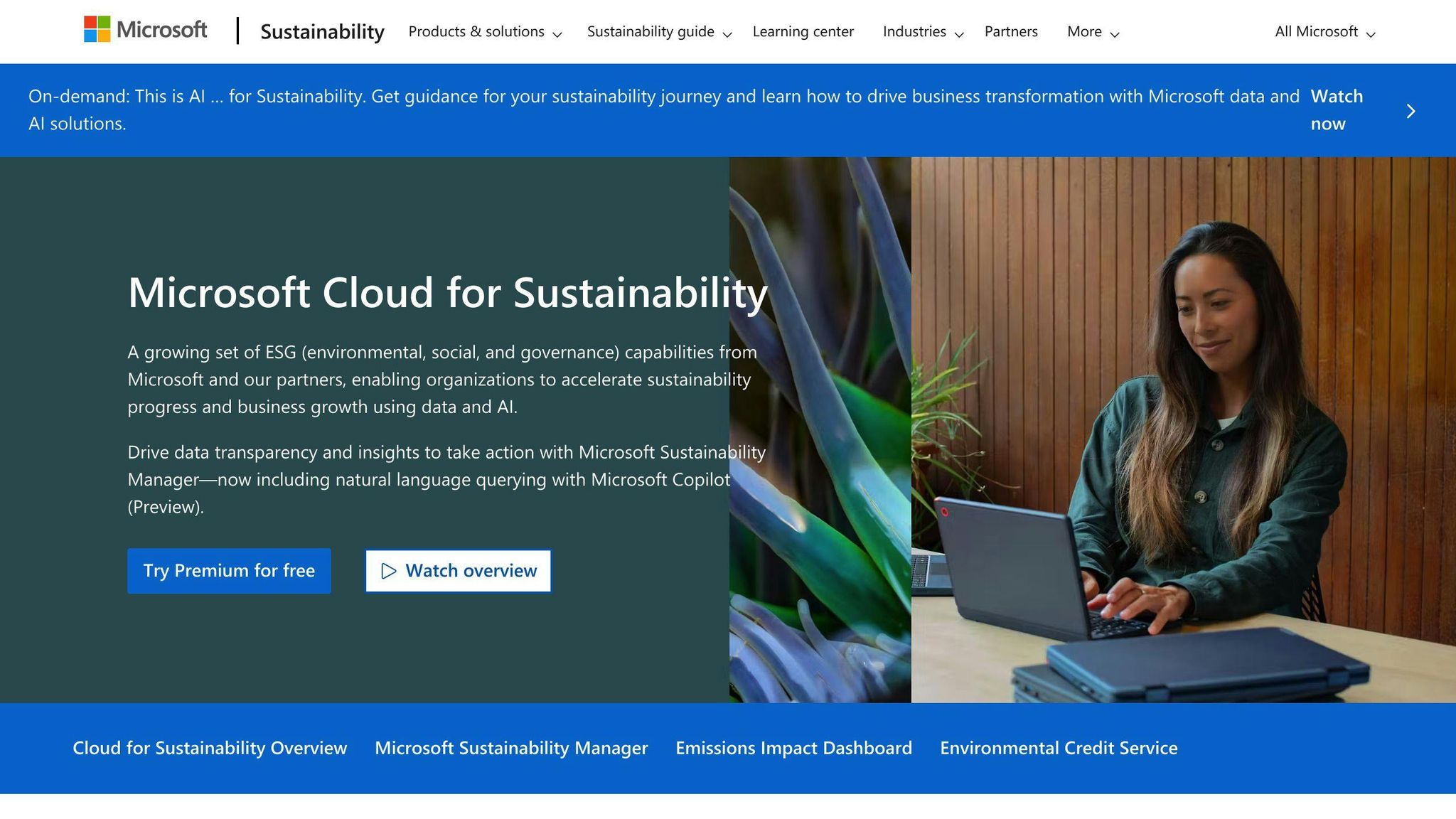
Microsoft Sustainability Cloud is a comprehensive carbon accounting platform designed to help organisations accelerate their sustainability journey. Here's an overview of its features and capabilities:
Scope Coverage
Microsoft Sustainability Cloud covers all three scopes of emissions:
| Scope | Description |
|---|---|
| 1 | Direct emissions from owned or controlled sources |
| 2 | Indirect emissions from purchased energy |
| 3 | Value chain emissions |
Integration and Analytics
The platform integrates with existing systems and data sources, enabling organisations to collect and analyse emissions data. Microsoft Sustainability Cloud uses AI to automate data formatting, detect anomalies, and allocate emission factors, reducing the time and effort required for data management.
Real-time Analytics
The platform provides real-time analytics and reporting capabilities, allowing organisations to track their emissions and make data-driven decisions.
Cost and User Experience
Cost-effective
Microsoft Sustainability Cloud offers a cost-effective solution for organisations of all sizes and industries.
User Interface
The platform is designed to be user-friendly, with an intuitive interface that makes it easy to navigate and use. Microsoft Sustainability Cloud also provides personalised support and training to ensure that users get the most out of the platform.
Scalability and Industry Expertise
Scalability
Microsoft Sustainability Cloud is a scalable solution, making it suitable for organisations of all sizes and industries.
Industry Experience
Microsoft has experience working with organisations in various industries, including enterprise, financial institutions, and SMB markets.
Compliance and Reporting
Microsoft Sustainability Cloud is designed to meet regulatory requirements and industry standards, including GHGP and PCAF. The platform's reporting capabilities enable organizations to generate reports that meet the requirements of various stakeholders, including investors, regulators, and customers.
Microsoft Sustainability Cloud empowers organisations to accelerate their sustainability progress while driving business growth. By leveraging the platform's comprehensive features and capabilities, organisations can reduce their environmental footprint, improve ESG performance, and create a more sustainable future.
3. Net Zero Cloud by Salesforce
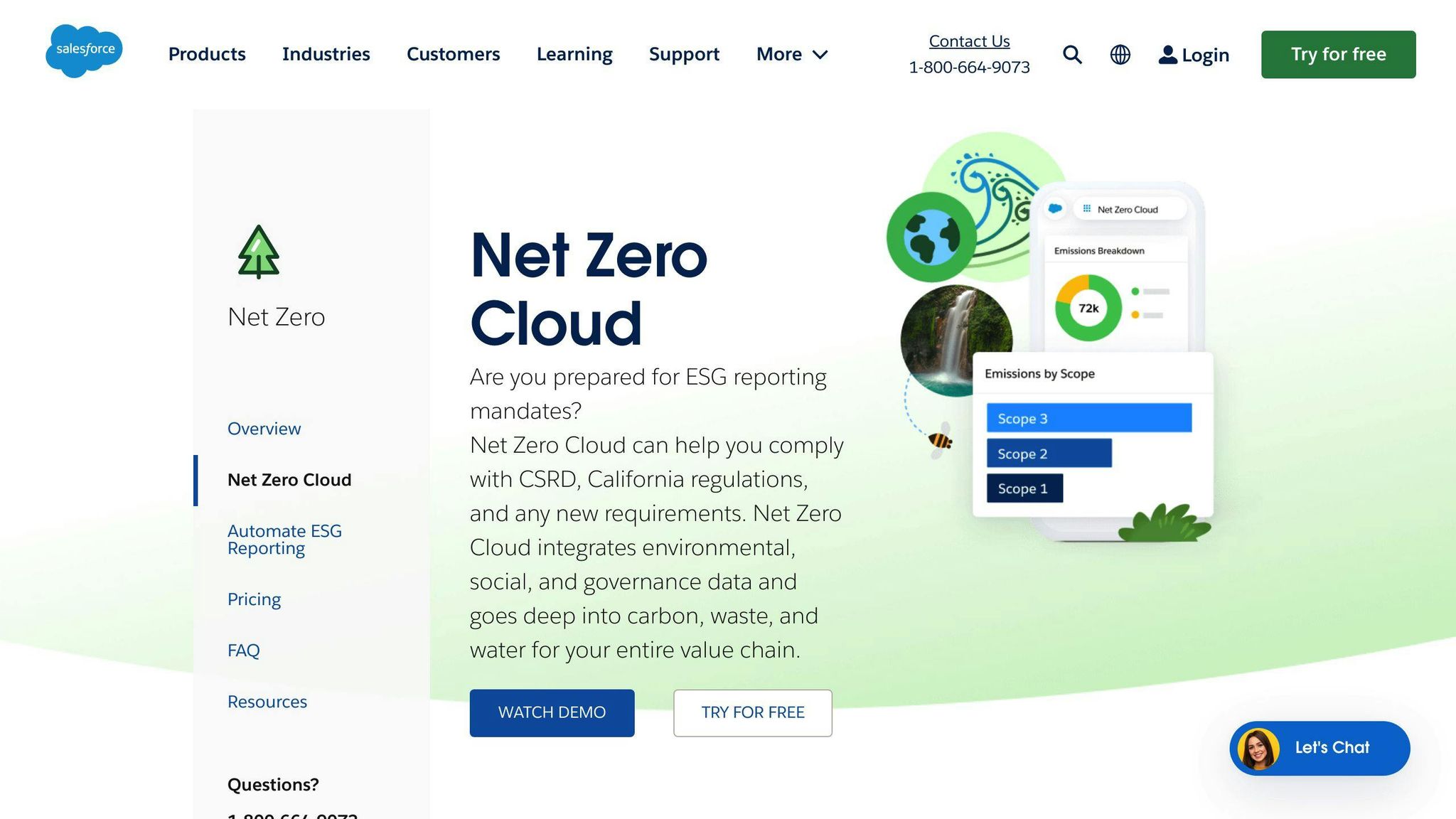
Net Zero Cloud by Salesforce is a comprehensive carbon accounting solution designed to help organisations manage their environmental footprint and achieve their sustainability goals. Here's an overview of its features and capabilities:
Integration Capabilities
Net Zero Cloud integrates with various data sources, enabling organisations to collect and analyse emissions data from diverse sources. The platform's fusion with Salesforce provides it with powerful capabilities for data integration, analysis, and collaboration.
Real-time Analytics
The platform offers real-time analytics and reporting capabilities, allowing organisations to track their emissions and make data-driven decisions.
Cost-effectiveness
Net Zero Cloud offers three pricing plans: Starter, Growth, and custom plans for larger enterprises. The Starter plan costs $48,000 per year, including 3 full CRM licenses, while the Growth plan costs $210,000 per year, including 5 CRM licenses.
User Interface
The platform is designed to be user-friendly, with an intuitive interface that makes it easy to navigate and use. Net Zero Cloud also provides personalised support and training to ensure that users get the most out of the platform.
Compliance and Reporting
Net Zero Cloud is designed to meet regulatory requirements and industry standards, including GHGP and PCAF. The platform's reporting capabilities enable organisations to generate reports that meet the requirements of various stakeholders, including investors, regulators, and customers.
Here is a summary of Net Zero Cloud's features and capabilities:
| Feature | Description |
|---|---|
| Integration | Integrates with various data sources |
| Real-time Analytics | Offers real-time analytics and reporting capabilities |
| Cost-effectiveness | Offers three pricing plans: Starter, Growth, and custom plans |
| User Interface | Designed to be user-friendly with an intuitive interface |
| Compliance and Reporting | Meets regulatory requirements and industry standards |
Net Zero Cloud by Salesforce empowers organisations to manage their environmental impact, track their progress toward net zero, and make data-driven decisions to reduce their carbon footprint.
4. IBM Environmental Intelligence Suite
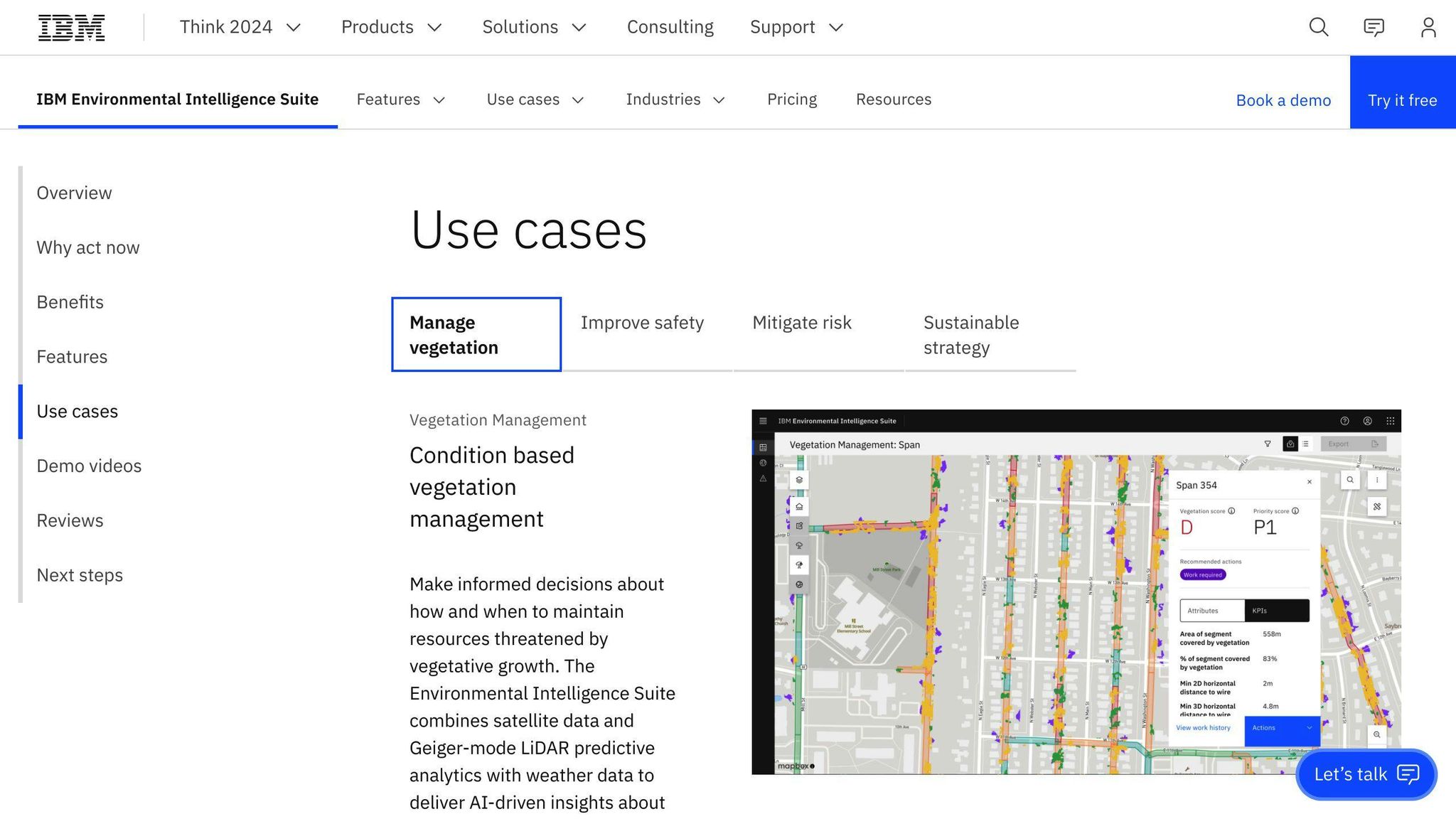
IBM Environmental Intelligence Suite is a comprehensive carbon accounting solution designed to help organisations manage their environmental footprint and achieve their sustainability goals. Here's an overview of its features and capabilities:
Integration Capabilities
The suite integrates with various data sources, enabling organisations to collect and analyse emissions data from diverse sources.
Real-time Analytics
The platform offers real-time analytics and reporting capabilities, allowing organisations to track their emissions and make data-driven decisions.
Cost-effectiveness
The suite helps organisations reduce emissions and improve their resilience to climate change, leading to significant cost savings in the long run.
User Interface
The platform is designed to be user-friendly, with an intuitive interface that makes it easy to navigate and use.
Compliance and Reporting
The suite is designed to meet regulatory requirements and industry standards, including GHGP and PCAF. The platform's reporting capabilities enable organisations to generate reports that meet the requirements of various stakeholders.
Here is a summary of the IBM Environmental Intelligence Suite's features and capabilities:
| Feature | Description |
|---|---|
| Integration | Integrates with various data sources |
| Real-time Analytics | Offers real-time analytics and reporting capabilities |
| Cost-effectiveness | Helps organisations reduce emissions and improve resilience to climate change |
| User Interface | Designed to be user-friendly with an intuitive interface |
| Compliance and Reporting | Meets regulatory requirements and industry standards |
The IBM Environmental Intelligence Suite empowers organisations to manage their environmental impact, track their progress toward sustainability goals, and make data-driven decisions to reduce their carbon footprint.
5. Sphera

Sphera is a leading provider of Environmental, Social, and Governance (ESG) performance and risk management software, data, and consulting services. Its carbon accounting and reporting solution helps companies easily collect GHG emissions data, calculate their carbon footprint, and respond to various reporting frameworks and stakeholder initiatives.
Scope Coverage
Sphera's solution covers Scope 1, Scope 2, and Scope 3 emissions, enabling companies to track and manage their direct and indirect emissions.
Integration Capabilities
The platform integrates with various data sources, allowing companies to collect and analyse emissions data from diverse sources.
Real-time Analytics
The platform offers real-time analytics and reporting capabilities, enabling companies to track their emissions and make data-driven decisions.
Cost-effectiveness
Sphera's solution helps companies reduce emissions and improve their resilience to climate change, leading to significant cost savings.
Here is a summary of Sphera's features and capabilities:
| Feature | Description |
|---|---|
| Scope Coverage | Covers Scope 1, 2, and 3 emissions |
| Integration | Integrates with various data sources |
| Real-time Analytics | Offers real-time analytics and reporting capabilities |
| Cost-effectiveness | Helps companies reduce emissions and improve resilience to climate change |
Sphera's comprehensive carbon accounting and reporting solution empowers companies to manage their environmental impact, track their progress towards sustainability goals, and make data-driven decisions to reduce their carbon footprint.
6. Sinai Technologies
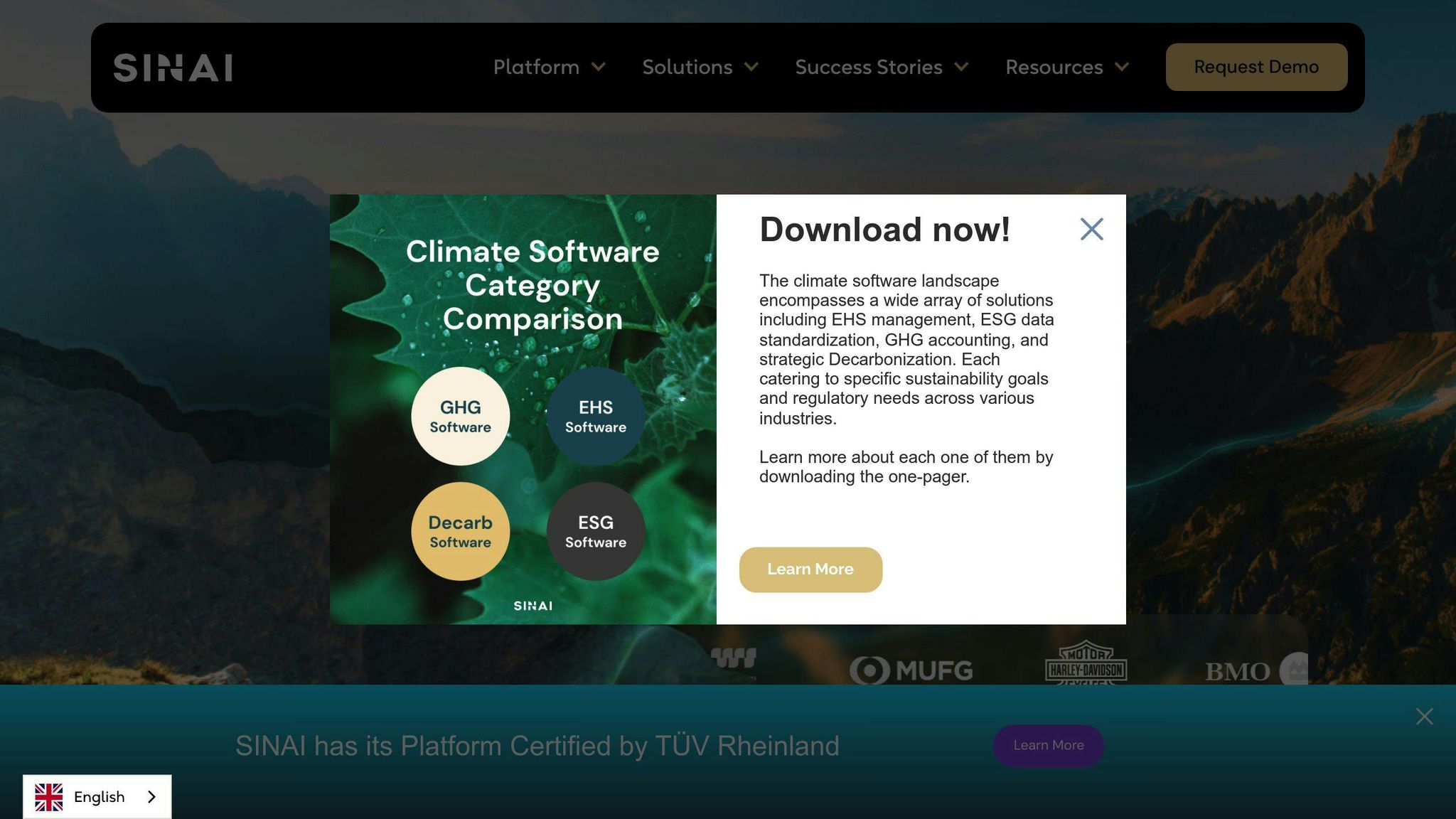
Sinai Technologies is a leading provider of carbon accounting software, helping organisations achieve carbon neutrality through various methods, including carbon accounting, offsets & removals, and setting targets.
Emission Factors Database
The platform's emission factors database includes reputable sources such as the Environment Protection Agency (EPA), Intergovernmental Panel on Climate Change (IPCC), Greenhouse Gas Protocol (GHG), and Department for Environment, Food, Rural Affairs (DEFRA). This ensures transparent and auditable calculations, enabling companies to make informed decisions about their carbon footprint.
Cost Savings
By using Sinai Technologies' carbon accounting software, companies can reduce greenhouse gas emissions, leading to significant cost savings. This is achieved by investing in renewable energy sources and reducing reliance on traditional forms of energy generation.
Here is a summary of Sinai Technologies' features and capabilities:
| Feature | Description |
|---|---|
| Emission Factors Database | Includes reputable sources such as EPA, IPCC, GHG, and DEFRA |
| Cost Savings | Helps companies reduce emissions and save costs |
Sinai Technologies' comprehensive carbon accounting software empowers companies to manage their environmental impact, track their progress towards sustainability goals, and make data-driven decisions to reduce their carbon footprint.
sbb-itb-919600f
7. Emitwise
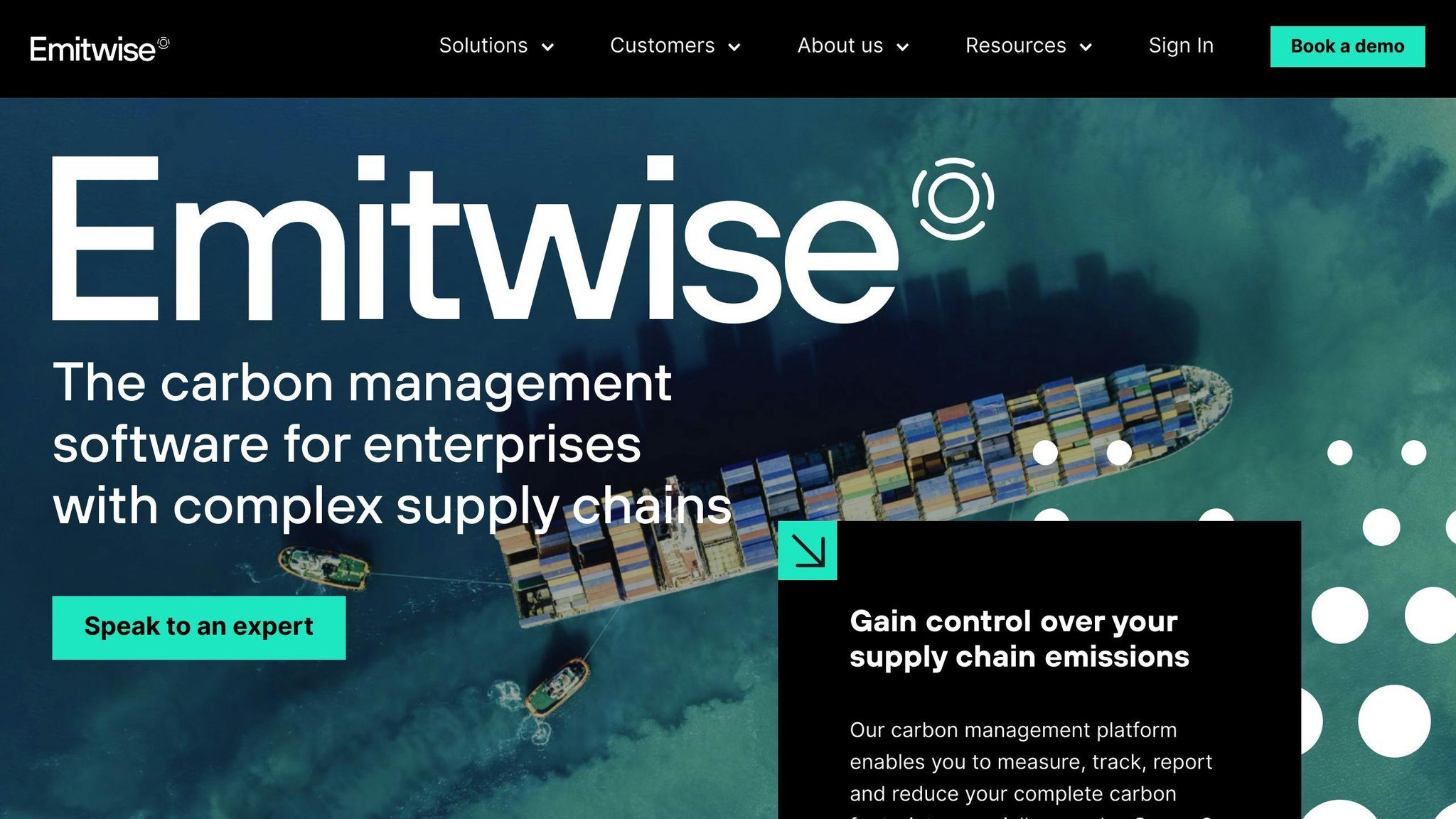
Emitwise is a carbon management platform designed for manufacturing businesses and supply chains, helping them understand, track, and reduce their carbon footprint. The platform combines expertise with machine learning technology to accelerate climate action.
Scope Coverage
Emitwise provides full scope 3 emissions data, enabling businesses to measure and manage their entire carbon footprint, including emissions from their supply chain.
Integration and Analytics
The platform integrates with existing systems, automatically collecting emissions data in real-time. This provides businesses with accurate and up-to-date emissions information, enabling them to make informed decisions.
Supplier Collaboration
Emitwise allows businesses to work closely with suppliers to reduce their emissions, providing a single source of truth for carbon data.
Cost Savings
By automating emission data collection and providing actionable insights, Emitwise helps businesses reduce costs and improve their sustainability performance.
Here is a summary of Emitwise's features and capabilities:
| Feature | Description |
|---|---|
| Scope Coverage | Full scope 3 emissions data |
| Integration and Analytics | Real-time data collection and analytics |
| Supplier Collaboration | Single source of truth for carbon data |
| Cost Savings | Automation and actionable insights for cost reduction |
Emitwise's comprehensive carbon management platform empowers businesses to take control of their environmental impact, track their progress towards sustainability goals, and make informed decisions to reduce their carbon footprint.
8. Greenly

Greenly is a carbon accounting software that helps companies reduce their carbon footprint and achieve net-zero emissions. The platform offers a comprehensive solution for measuring, reporting, and actively reducing carbon emissions.
Scope Coverage
Greenly provides full scope 1, 2, and 3 emissions data, enabling businesses to measure and manage their entire carbon footprint.
Integration and Analytics
The platform integrates with existing systems, automatically collecting emissions data in real-time. This provides businesses with accurate and up-to-date emissions information.
Supplier Collaboration
Greenly allows businesses to work closely with suppliers to reduce their emissions, providing a single source of truth for carbon data.
Cost Savings
By automating emission data collection and providing actionable insights, Greenly helps businesses reduce costs and improve their sustainability performance.
Here is a summary of Greenly's features and capabilities:
| Feature | Description |
|---|---|
| Scope Coverage | Full scope 1, 2, and 3 emissions data |
| Integration and Analytics | Real-time data collection and analytics |
| Supplier Collaboration | Single source of truth for carbon data |
| Cost Savings | Automation and actionable insights for cost reduction |
Greenly's comprehensive carbon management platform empowers businesses to take control of their environmental impact, track their progress towards sustainability goals, and make informed decisions to reduce their carbon footprint.
9. Diligent
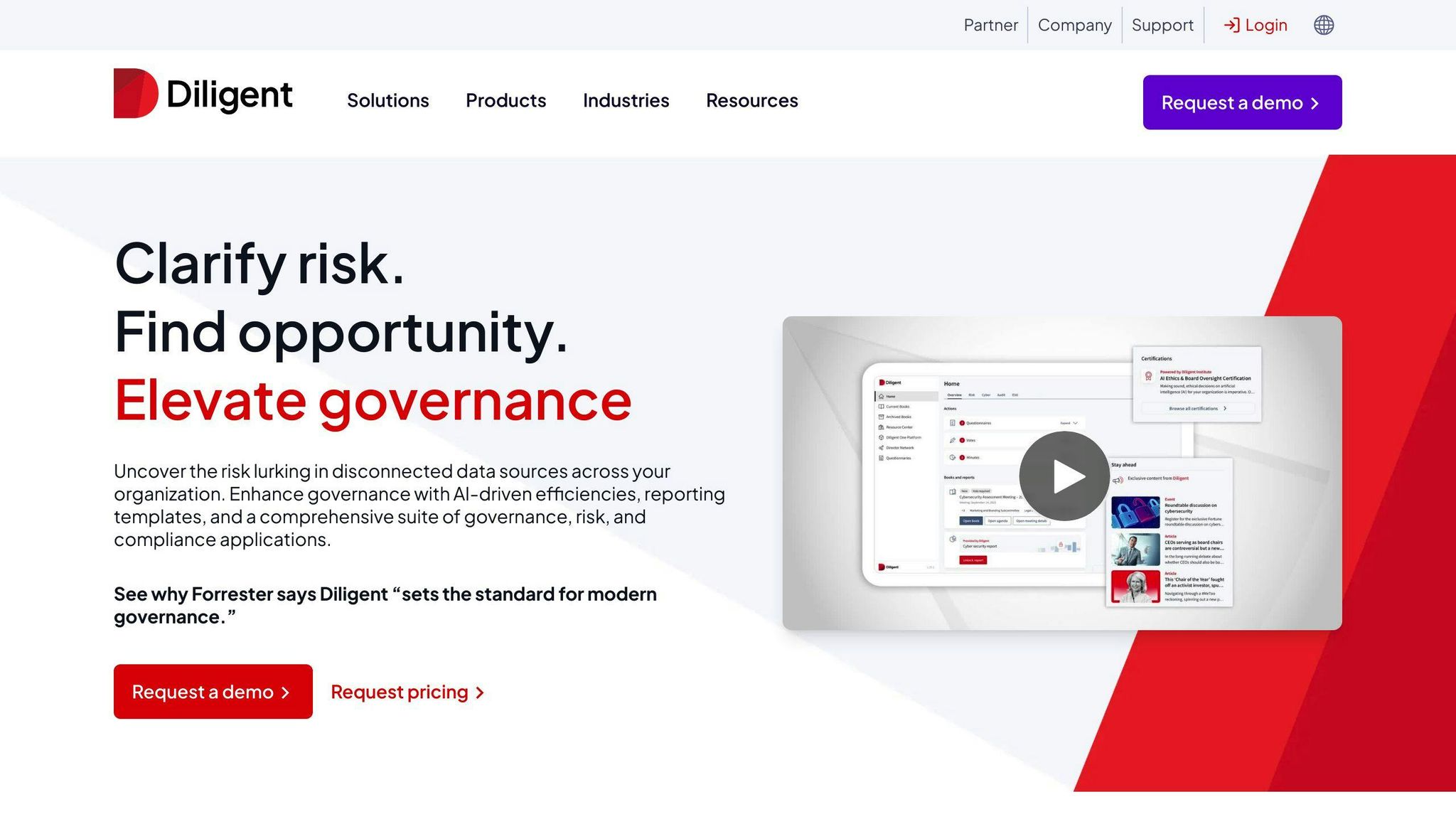
Diligent is a comprehensive ESG software solution that helps companies monitor their performance against ESG objectives in real-time.
Integration Capabilities
The platform connects to multiple internal platforms and data sources, allowing companies to collect and analyse ESG data from across their organisation.
Real-time Analytics
Diligent provides real-time dashboards focused on ESG performance, enabling companies to track their progress towards sustainability goals and make informed decisions.
Cost Savings
The platform helps companies reduce costs and improve their sustainability performance by automating emission data collection and providing actionable insights.
Compliance and Reporting
Diligent offers a purpose-built carbon calculator feature, providing instant calculations and auditable, submission-ready reports for SEC climate disclosure requirements. The platform also enables companies to generate disclosures with a single click, ensuring complete coverage across Scopes 1, 2, and 3 emissions.
Here is a summary of Diligent's features and capabilities:
| Feature | Description |
|---|---|
| Integration Capabilities | Connects to multiple internal platforms and data sources |
| Real-time Analytics | Provides real-time dashboards focused on ESG performance |
| Cost Savings | Automates emission data collection and provides actionable insights |
| Compliance and Reporting | Offers a purpose-built carbon calculator and auditable reports |
Diligent ESG is a powerful tool for companies seeking to measure and report their climate impacts and risks, and turn their ESG goals into outcomes.
10. Sweep
Sweep is a comprehensive carbon accounting software designed to help businesses measure, manage, and reduce their carbon emissions. The platform offers a range of features to support companies in their sustainability journey.
Scope Coverage
Sweep covers a wide range of carbon accounting methodologies, including the GHG Protocol, across all scopes and categories.
Integration Capabilities
The platform integrates with various data sources, enabling companies to collect and analyse ESG data from across their organisation.
Real-time Analytics
Sweep provides real-time dashboards focused on ESG performance, enabling companies to track their progress towards sustainability goals and make informed decisions.
Supplier Engagement
The platform allows companies to engage their suppliers in their climate journey, using surveys for efficient data gathering.
Cost-effectiveness
Sweep helps companies reduce costs and improve their sustainability performance by automating emission data collection and providing actionable insights.
Here is a summary of Sweep's features and capabilities:
| Feature | Description |
|---|---|
| Scope Coverage | Covers GHG Protocol across all scopes and categories |
| Integration Capabilities | Integrates with various data sources |
| Real-time Analytics | Provides real-time dashboards focused on ESG performance |
| Supplier Engagement | Enables supplier engagement through surveys |
| Cost-effectiveness | Automates emission data collection and provides actionable insights |
Sweep is a powerful tool for companies seeking to measure and report their climate impacts and risks, and turn their ESG goals into outcomes.
Pros and Cons
When choosing a carbon accounting software, it's essential to weigh the advantages and disadvantages of each solution. Here's a summary of the pros and cons of each software in a comparative table:
| Software | Pros | Cons |
|---|---|---|
| Persefoni | Easy to use, standardised approach, collaboration tools | Limited advanced features, may not be suitable for large enterprises |
| Microsoft Sustainability Cloud | Integrates well with Microsoft suite, user-friendly environment | Limited compatibility with other applications, may not be suitable for diverse software environments |
| Net Zero Cloud by Salesforce | Leverages Salesforce's robust platform, integrates carbon tracking seamlessly | Dependent on Salesforce platform, may pose challenges for businesses using alternative CRM solutions |
| IBM Environmental Intelligence Suite | Extensive data analytics capabilities, powerful insights into environmental impact | Complex and advanced features may require significant resources and investment |
| Sphera | Broad range of environmental, health, safety, and sustainability solutions, comprehensive solution for organisations with diverse needs | Extensive features may lead to limited capacity, especially in open modelling, primary data collection, and scalability |
| Sinai Technologies | AI-driven sustainability solutions, precise carbon footprint assessments, real-time data analysis | Reliance on AI technology may pose challenges for businesses with limited resources or those less comfortable with advanced technological solutions |
| Emitwise | Automated carbon footprint calculations, accurate data management and reporting, supply chain engagement | Limited information available on features and capabilities |
| Greenly | User-friendly interface, automated carbon footprint calculations, accurate data management and reporting | Limited information available on features and capabilities |
| Diligent | Comprehensive carbon accounting solution, accurate data management and reporting, supply chain engagement | Limited information available on features and capabilities |
| Sweep | Comprehensive carbon accounting software, covers wide range of carbon accounting methodologies, integrates with various data sources | May require significant resources and investment for implementation and maintenance |
By considering the pros and cons of each software, you can make an informed decision about which solution best fits your organisation's needs and goals.
Final Thoughts
Choosing the right carbon accounting software is crucial for SMEs to manage their carbon footprint effectively, reduce emissions, and contribute to a sustainable future.
Key Considerations
When selecting a carbon accounting software, consider the following factors:
| Factor | Description |
|---|---|
| Ease of use | Is the software user-friendly and easy to navigate? |
| Integration | Does the software integrate with existing systems and data sources? |
| Cost-effectiveness | Is the software cost-effective and provides value for money? |
| Support | Does the software provider offer reliable support and training? |
Next Steps
If you're interested in adopting a carbon accounting software, explore each option in more detail. Take advantage of free demos or trials to get hands-on experience with the tools and assess their suitability for your organisation.
By taking the first step towards carbon accounting and sustainability, SMEs can reduce their environmental impact, save costs, and enhance their brand reputation.
Remember, selecting the right carbon accounting software is a crucial step towards a more sustainable future.
Research Process
We followed a thorough research process to create this comprehensive guide to the top 10 carbon accounting software solutions. Our goal was to provide an unbiased and informative evaluation of the best carbon accounting software available for SMEs.
Evaluation Criteria
We assessed each software solution based on the following key factors:
| Factor | Description |
|---|---|
| Features | We examined the range of features offered by each software, including carbon footprint tracking, reporting, and analytics capabilities. |
| Pricing | We compared the pricing models and costs associated with each software solution. |
| User Reviews | We analysed user reviews and ratings from various sources to gauge user satisfaction and experience. |
| Industry Expertise | We considered the expertise and experience of each software provider in the field of carbon accounting and sustainability. |
| Integration | We evaluated the ease of integration with existing systems and data sources. |
Research Methodology
Our research process involved:
- Reviewing product documentation and technical specifications
- Conducting demos and trials to gain hands-on experience
- Analysing user reviews and ratings from various sources
- Consulting with industry experts and thought leaders
- Comparing features, pricing, and user experience across each software solution
FAQs
What is carbon footprint monitoring?
Carbon footprint monitoring is a process that helps organisations track and measure their greenhouse gas emissions. This is done using specialised software that collects and analyses data from various sources.
Why is carbon footprint monitoring important?
Carbon footprint monitoring is crucial for organisations to understand their environmental impact and develop strategies to reduce their emissions. This helps them comply with regulations, improve their brand reputation, and contribute to a more sustainable future.
What are the benefits of using carbon accounting software?
| Benefit | Description |
|---|---|
| Accurate tracking | Easily track and measure greenhouse gas emissions |
| Compliance | Comply with carbon reporting regulations |
| Cost savings | Reduce costs by identifying areas of improvement |
| Brand reputation | Enhance brand reputation by demonstrating commitment to sustainability |
| Sustainability | Contribute to a more sustainable future |
How does carbon accounting software work?
Carbon accounting software collects data from various sources, including energy consumption, transportation, and supply chain activities. The software then analyses the data to provide a comprehensive picture of an organisation's carbon footprint.
What are the key features of carbon accounting software?
| Feature | Description |
|---|---|
| Data collection | Collects data from various sources |
| Data analysis | Analyses data to provide a comprehensive picture of carbon footprint |
| Reporting | Generates reports to comply with regulations and stakeholders |
| Integration | Integrates with existing systems and data sources |
| Support | Provides support and training for users |

